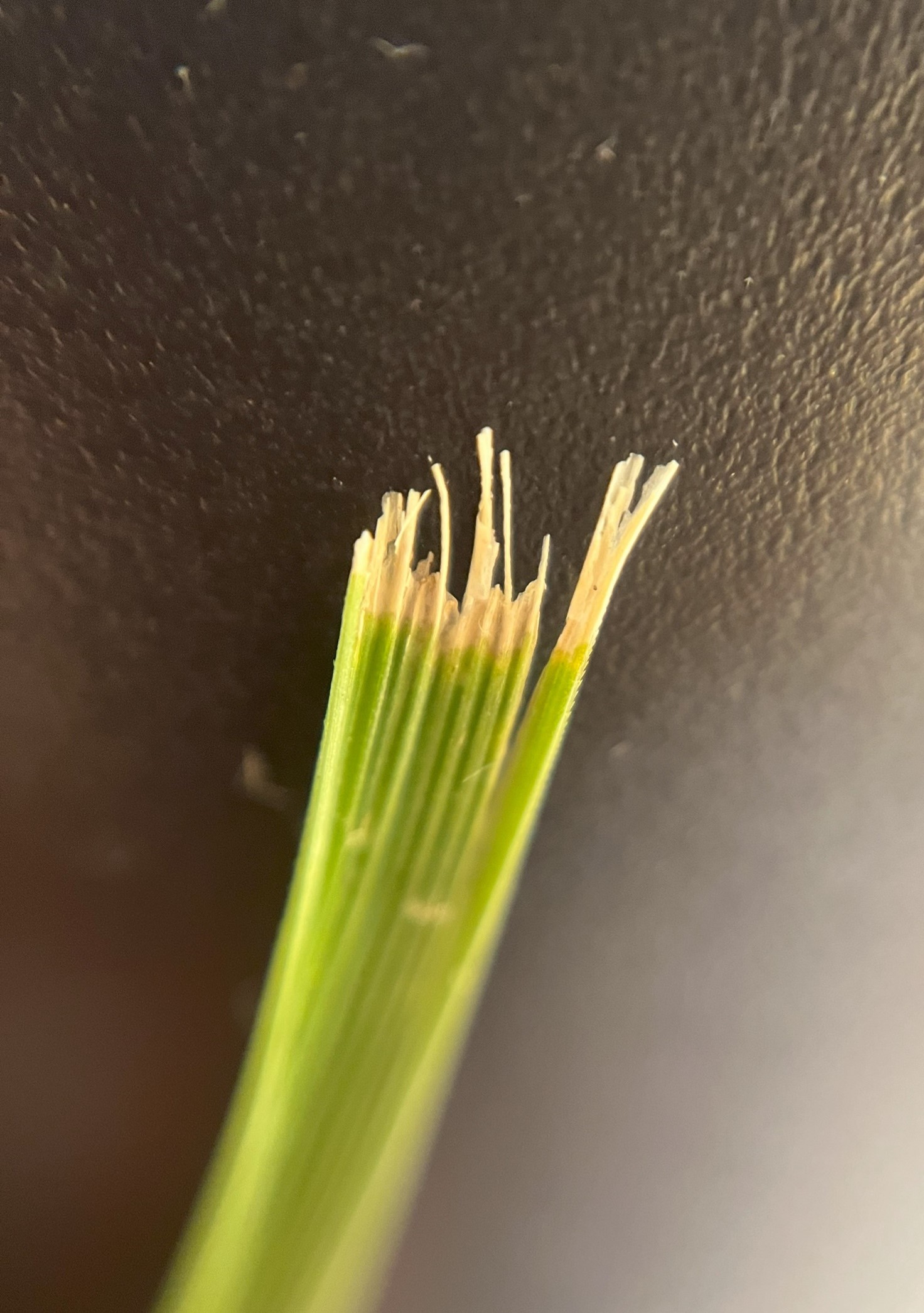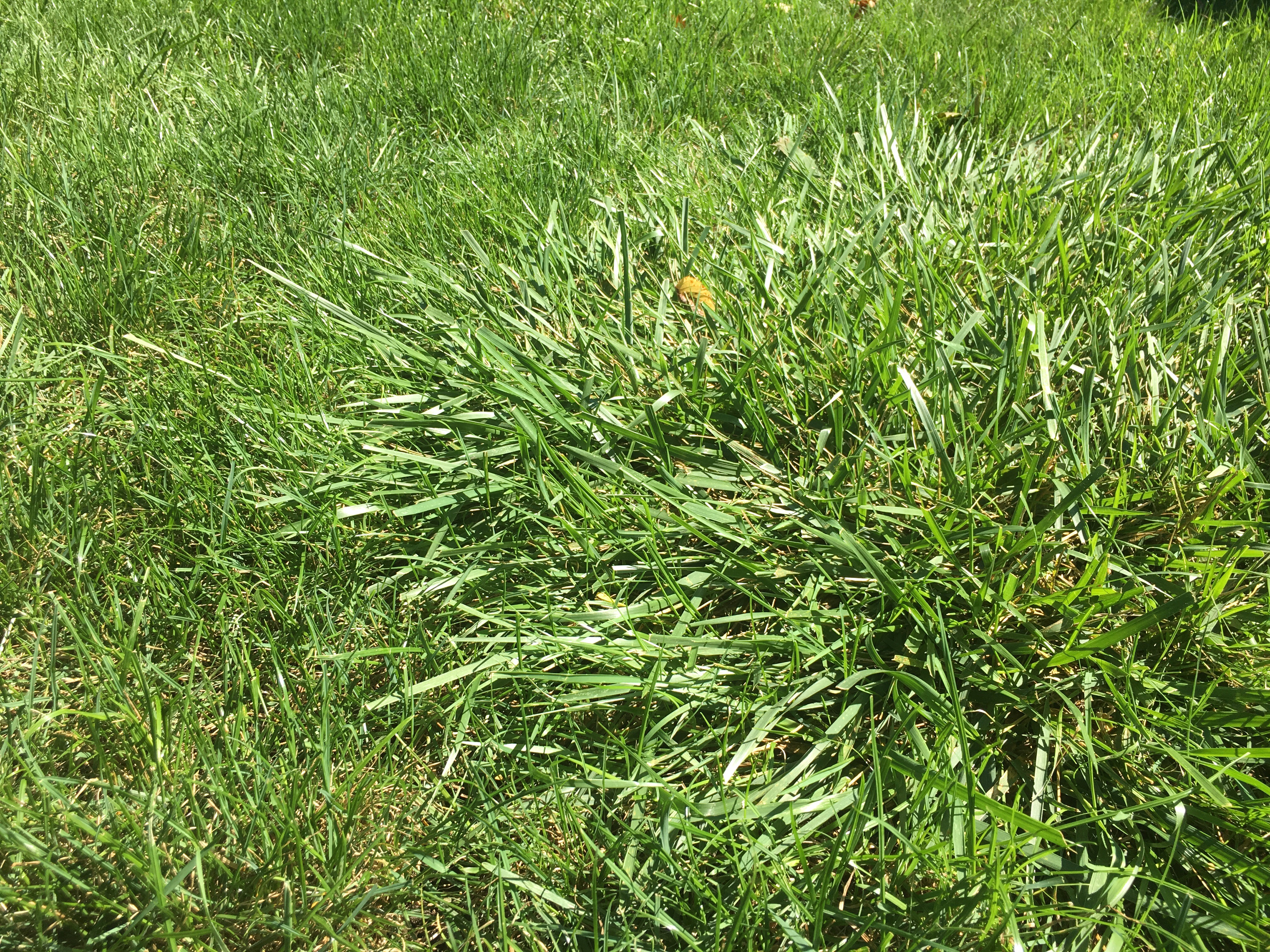Pain in the grass: Tall fescue
Not all weedy grasses are crabgrass. Tall fescue is one of the top grassy weed complaints received by MSU Extension and MSU Plant & Pest Diagnostics each year.

Tall fescue (Schedonorus arundinaceus, also known as Lolium arundinacea or Festuca arundinaceae) is an introduced, perennial cool-season grass species in Michigan. It is a bunch-type grass that expands through tillering and seed production. It does not produce stolons or rhizomes. While there are varieties of tall fescue used to seed turf areas, this species is less popular than others (e.g., Kentucky bluegrass, ryegrasses and fescues) for residential lawns in Michigan.
While improved turf-type varieties of tall fescue have narrow leaf blades like Kentucky bluegrass, the patches typically found infesting bluegrass lawns are forage types of tall fescue such as Kentucky 31 (KY-31) that have wide leaf blades (up to around 0.5 inches) and often appears to have a jagged cut after mowing (Photo 2), which disturbs the uniformity of most lawns. In droughty summer months in the absence of irrigation, tall fescue may be the last remaining green grass as other desirable cool-season species go dormant in the heat.

To further confirm the identity of tall fescue, take a closer look at the collar region, where the leaf meets the sheath. Often, there is a distinct light-colored band at the base of the leaf (Photo 3). Tall fescue also has a very short membranous ligule (skin-like appendage at leaf base) and lobe-like auricles (protrusions at the leaf base that somewhat hug the stem, this feature is variable). In addition to examining the collar, the leaves are not only wide but also clearly grooved.

If the infestation is small, you can dig the grass clumps out with a shovel, just ensure that the entire crown and top few inches of roots are removed. You can then add soil and replant the desired grass from seed. If the infestation is larger, use a nonselective herbicide such as glyphosate to kill the grass (e.g., Roundup Weed and Grass Killer, though there are many others). Keep in mind this will kill the lawn grass too, so take care to spray as little as possible.
When using products containing glyphosate, there are a few important points to consider. First, as with any pesticide, remember to read and follow all labeled instructions. Second, glyphosate is a broad-spectrum herbicide, meaning it will injure or kill other plants contacted during application, so care is needed to avoid green plant material, exposed roots and injured bark of desired plants. Third, glyphosate is relatively safe in the environment when used as labeled. It adsorbs strongly to soil in most cases (i.e., clay and organic matter), allowing replanting shortly after application. This means no carryover issues are expected.
Fourth, glyphosate does not offer instant gratification. When used alone, it can take up to 14 days (about two weeks) to show full activity under ideal growing conditions. Retreating the area will likely be needed depending on the degree of infestation (treating at intervals of three to four weeks). Glyphosate is most effective for perennial control (like tall fescue) in the fall, prior to frost, but can be applied anytime the plants are actively growing (temperatures consistently above 50 degrees Fahrenheit). Do not mow immediately before or after the herbicide application; the goal is to maximize the leaf area for herbicide absorption and minimize stress (counter intuitive).
Finally, be sure that the product chosen has only the active ingredient glyphosate. Some products will also include small quantities of pelargonic acid or diquat for rapid results. These are OK with this particular grassy weed since it does not have stolons or rhizomes. Be sure that it is not an “extended control” or “365” type product, as the high percentages may have adverse effects. Products with additional active ingredients not already mentioned (e.g., imazapic) may have other unwanted effects, and/or may delay the planting of other plants in the coming season(s) and should be avoided. The label will indicate appropriate uses.

After tall fescue control has been achieved and the area is replanted, the work is not over. There are two more important things to consider.
- While this will not reduce tall fescue already in place, creating a robust/vigorous stand of grass in your lawn will create a competitive environment for all weeds to prevent germination and establishment. Practices could include fertilizing the lawn (early spring and/or early fall), watering when conditions are dry (but not overwatering) and increasing your mowing height (about 3.5 inches, this is healthier for the grass and makes it more competitive).
- Keep an eye out for any new tall fescue appearing and spot treat as necessary. Visit Michigan State University Extension’s Home Lawns website for more information on lawn care from the MSU turfgrass team.
To learn more about other weedy grasses that occur in lawns, visit the other articles in the Pain in the Grass series.
If you need help identifying your weedy grass, consider reaching out to your local MSU Extension office or contacting MSU Plant & Pest Diagnostics.
Thanks to Angie Tenney for reviewing this article.



 Print
Print Email
Email




